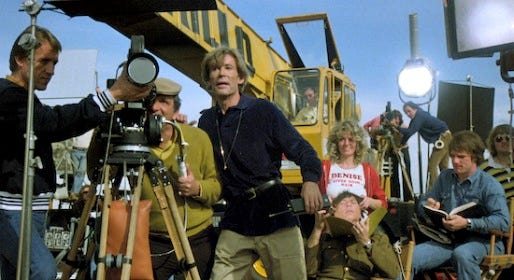The Stunt Man (1980)

"The Stunt Man" received three Academy Award nominations and deserved none of them.
Well, I will concede that Peter O'Toole has a memorable presence as an egomaniacal film director who rides around in helicopters or on crane booms and appears, like a fourth-rate deity, to be everywhere at once. If he isn't exactly all-knowing about every move made by his cast and crew, he seems to have guessed at most of it.
But is this worthy of a Best Actor nod? I would conclude not, since it's not a particularly meaty role. O'Toole's Eli Cross shows up for a moment or two, speaks a few cryptic lines of dialogue and then disappears. We never really learn much about him or what motivates him. He's not so much a character as a plot device. Not to mention, his role is really a supporting one.
Director Richard Rush and screenwriter Lawrence B. Marcus (who worked with Rush to adapt the script from Paul Brodeur's novel) also received Oscar nominations, the only ones of their otherwise un-noteworthy careers. (Rush would not make another movie for 14 years, and when he did, it was the laughably bad sexual thriller "Color of Night," universally known The Flick That Features Bruce Willis' Dick.)
It's pretty obvious that, with "The Stunt Man," Rush and Marcus were trying to make some grand statement about ... well, that's where it gets a little fuzzy. About the emotionally traumatized veterans returning from Vietnam, certainly. About the vicissitudes and vagaries of moviemaking in Hollywood, probably.
The plot is straightforward but nonsensical. Cameron (Steve Railsback), a Vietnam vet on the run from the law, stumbles onto a movie set where Eli Cross is shooting a war extravaganza that is supposed to be anti-war but keeps missing expectations and is looking more like an action/adventure.
Cameron was involved in a car accident with a vintage Duesenberg careening off a bridge into the river, killing the production's head stuntman in the process. Eli realizes the fix Cameron is in and, also needing to conceal the death from the local head of police (Alex Rocco) constantly threatening to shut them down, casts Cameron to stand in for the stuntman.
Alternately called Burt (after the dead stunt man) or Lucky (for his death-defying antics), Cameron falls for the leading lady, Nina Franklin (Barbara Hershey), and becomes increasingly convinced that Eli is trying to kill him.
Eli's motivations for making Lucky his thrall are entirely unclear. Why would he cast a total novice in such an important role, knowing he could screw up at any time and lead to another accident? Eli delights in demonstrating to Lucky that his crew will do anything he tells them to, including pretending that he's the dead stuntman. If that's the case, then why wouldn't he just choose another one of his real stuntmen to impersonate the fallen one?
The sequences where the movie-within-the-movie are being shot are massive action setpieces that last up to 10 minutes, as Lucky falls through roofs, climbs towers, is shot at with (what he hopes are) blanks and performs other astonishing feats.
Rush makes the choice to present the film shoot as if it would actually play out this way, with one long continuous take. If one were to try to do that, it would involve hundreds of crew members and extras, dozens of cameras and a logistical challenge that would make the planning of D-Day look like roshambo.
In reality, Rush must've used dozens of setups to achieve this bit of fakery. Nowadays, when knowledge about filmmaking techniques is pretty common, this would seem ridiculous. I wonder if, back in 1980, audiences were really ignorant enough to swallow this hoo-hah.
Railsback strains mightily to bring some semblance of continuity to his character, but he's fighting the script. One moment Burt/Lucky/Cameron is serene and charming, and the next he's angrily relating his brutal attack on a police officer, spitting out the words like they're poisonous to his mouth. A little later, he's laughing and canoodling with Nina.
Some critics, notably Pauline Kael, hailed "The Stunt Man" as a brilliant bit of subversive filmmaking. That's quite a leap without a net.
2.5 Yaps



